I field a lot of questions about what I eat. The answer to that is, well, just about anything I want. Sometimes all it takes is a little creativity and a lot of commitment…
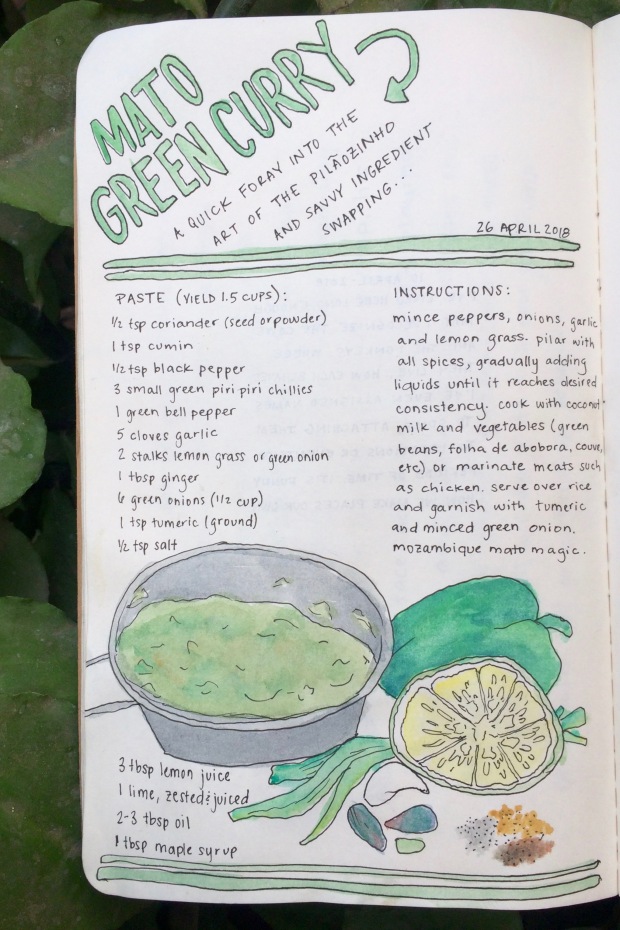
I field a lot of questions about what I eat. The answer to that is, well, just about anything I want. Sometimes all it takes is a little creativity and a lot of commitment…

Originating in Zambia, the Chewa tribe and self-proclaimed violent, warring culture slowly spread through southern Africa into Tete, Mozambique and areas of Malawi. Chewa is a traditionally matrilineal society, meaning property and power are passed through women and family lineages are traced through their female heads. Because of this, the Nyau was established to offer an opportunity for married men to attain status and create solidarity across villages. Highly revered and highly secretive, initiated members are forbidden to disclose their participation. Revelation of society secrets or community initiations of practices are subject to violent punishment.
Historically, the Nyau primarily served to initiate young men into adulthood, using the Gule Wamkulu to celebrate the harvest, funerals, weddings, and the inauguration and/or funeral of a village chief. While the Nyau and Gule Wamkulu still exist today, many of their practices and performances have been gradually co-opted by tourism and politics.
Much like what was seen in post-contact USA with the Ghost Dance and other cultural practices throughout the 19th and 20th centuries, the Portuguese and Christian missionaries in Mozambique tried to ban the Nyau and the Gule. Both were strictly prohibited in Tete province until the mid-1960s, demonstrations of the brotherhood punishable by death. Local residents reported that the Nyau only survived by adopting aspects of Christianity and integrating them into their ceremonies…an impact that can still be felt today despite the lifted ban and the national liberation from Portuguese rule. Living in a time to focused on globalization, we often do not realize the pervasive presence of colonization and colonialism in the contemporary world. It is real and there are still reparations to be made.
One of the largest carry-overs of colonialism among the Nyau and within the Gule can be found in their physical appearances. Prior to colonial contact and Western influences, clothing and masks were made entirely from natural materials sourced locally from trees, river beds, flora, mineral deposits, and more. Wood from the Mbwaba tree was carved into masks, the fibrous bark of the Nyanda tree was separated and softened to make clothing, monkey bean (also called feijão maluco or crazy bean) roots were ground into a fine powder to make green pigment, river sediment was burned to make yellow, and ashes or other pounded roots were used to change or deepen colors. Pigments were mixed with water or oils, egg being added to establish permanence through an air-drying process. It should be noted that once dancers assume their roles within the Gule, it is disrespectful (to say the least) to refer to them as humans as they are now portraying spirits or specific characters. This makes it challenging, if not impossible, to ask questions about masks and clothing worn during the Gule as it assumes they are dressed in some sort of costume or disguise.
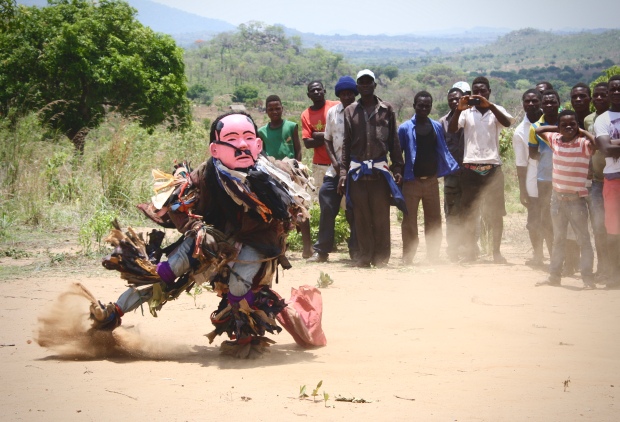
Chadzunda: the protagonist of the dance and leader of all other dancers
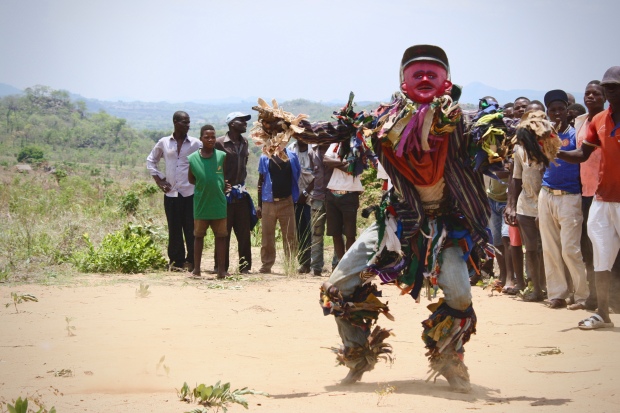
Apolisi: the protectors of peace through out the ceremony. Their primary function is to control the crowd watching the dance and pull aside any people who may be causing disturbances or problems. The Apolisi was added to the dance following colonial contact, its appearance being modeled after Portuguese army and police officers. Pre-colonial contact, the job of peacekeeper belonged to Chadzunda; today Chadzunda is only responsible for doling out prosecutions and punishments to those apprehended by the Apolisi.

Kapoli: prior to the start of the dance, Kapoli go door to door throughout the town’s neighborhoods calling women to the ceremony. As they run down streets and through winding paths, the Kapoli let out long, guttural, rising yelps to announce their approach and the imminent ceremony. The Kapoli are typically the first to start dancing while the other dancers arrive.

Silimoni: the partner to the Kapoli, sometimes accompany them from house to house, other times being the first to start dancing. The Silimoni is the only figure who may outwardly present as male or female through the flourish of their clothing or the flowing intricacy of their dance.
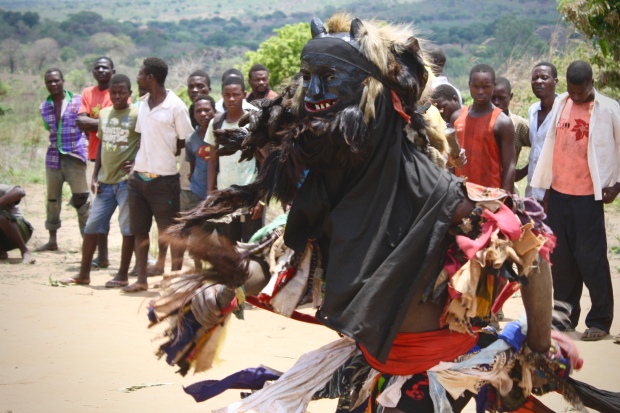
Chimbwabwa: the animal figure, representative of the various animals of the bush. Chimbwabwa primarily serve as entertainment for the crowd.
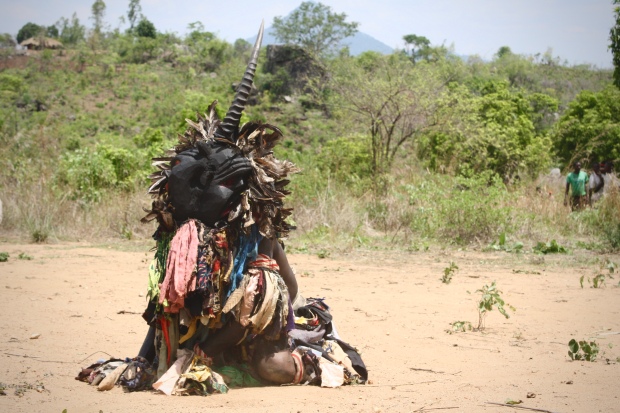
Aabaya Nkondo: warrior figure, representative of the warring tribes in the time before colonial contact. Thousands of years ago, wars were occurring across the region and were primarily being fought with bows and arrows; the two faces represent each of the warring tribes, the horn as the arrow splitting the two in half. The faces are intentionally grotesque and scary to serve as a warning about violence and the casualties of war. Aabaya Nkondo carries a machete as walking stick for guidance, thrusting it into the ground through out the dance and dropping to his knees in front of it.
Click on any of the below images to enlarge and read their captions:

Peace Corps Volunteers posing with dancers and leaders after the conclusion of the Gule Wamkulu, per the request of the King (green shirt and hat).
After a year of Peace Corps service, I once more photographed fellow volunteers and asked them to complete the same prompt, “I’m a firm believer that…” The results are nothing short of incredible.
In a world that seems to have gone mad, amongst a global population that seems to have lost its collective mind, these people keep me grounded, centered, humbled and hopeful that there will be better days ahead. A future with them in it surely means a brighter universe.
Thank you, Moz 26, for inspiring me every day. For pushing me to be better. For reminding me that there is good in this world. I’m honored to call you colleagues and, more importantly, consider you friends. Our numbers maybe be smaller after a year of service, but we are still strong. Parabéns on a successful first year, saúde for the year ahead, and estamos juntos always.

The Moz 26 cohort is currently attending a training with counterparts from our sites, and the Central region was able to take a few minutes to talk about our dreams for the future of women and how we get there, all in honor of today’s holiday.
As mentioned in my previous post, the Mozambique 26 cohort attended a Peace Corps sanctioned conference back in December, called Reconnect. While the main intent of the conference is to answer any questions we may have and cover any information we will need after our first 1/10 of service, it’s also an opportunity to catch up with fellow volunteers after 3 long months apart from each other.
Naturally, this felt like an ideal time to bother my fellow PCVs into doing a Reconnect installment of their photos from Pre-Service Training.
Unfortunately, our cohort was split into two separate groups (North and Central/South) due to the political conflict and embassy-instated travel restrictions, thus making my participant pool much smaller despite my constant nagging. Cheers to the kids who put up with me, y’all are the real MVPs.
In keeping with my theme of untimely posts, I present to you Moz 26, Revisited:




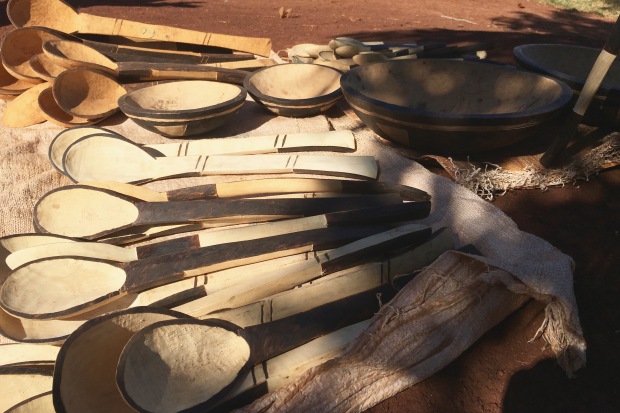
He pulls out a handful of wooden spoons and lays them in a pile. Reaching into his bag for more, this time he pulls out a group more ornately decorated. In the next handful the utensils are a smaller size. He repeats this ritual until his tarp is half filled by the three large mounds of spoons, each one uniquely different than the rest.
Then he turns back to his bag, his torso disappearing for a moment as he scrapes the bottom. He emerges with a stack of bowls and sets them, one by one, among the piles of spoons. Beautiful carved hills of black and white and soft cream.
He sits back for a moment, observes his work. He leans forward carefully, gingerly lifting a spoon and turning it over to show his best craftsmanship, slowly rotates a bowl to emphasize its design.
His name is Januário and he’s been doing this for over 30 years. The son of tailor, he decided that he did not want to follow in his father’s footsteps and instead taught himself to carve.
As a young man, Januário says he spent countless hours in the bush collecting the specific wood he needed and practicing. Once he was satisfied, he began painting some of his pieces black and decorating them with relief carvings.
Januário is very specific about which pieces he will part with. Despite having an interested buyer, some bowls, he says, he will not sell because of the small cracks that have begun to form at their mouths. Some spoons cannot go because their curves are not even. In true artist’s fashion, he will explain that he could not accept money for pieces that do not reach his standards. Could not send work that he does not feel good about out into the world.
After a buyer shows interest in a piece, he will pick it up and turn it over in his hands. Examine it slowly until giving it his approval. Then he reaches into a shirt pocket and pulls out a worn piece of sandpaper. He smoothes its curves and edges, explaining the meaning of each piece until the wood turns to silk. He explains the Bantu lineages of his carvings and the thousand-year journey they have taken to arrive on his ragged tarp beneath this shade tree in Namaacha.